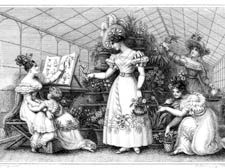|
|
 |
| |
Terribly house and garden at number 7b
Ruth Gorb on research that attempts to
get to the root of our desire to bring the outdoors into our homes
Potted History: the story of plants in the home. By Catherine Horwood.
Frances Lincoln £25
IT was in the 1950s that Michael Flanders and Donald Swann sang that “The garden’s full of furniture / And the house is full of plants…” It was, they said, the way to be “terribly up-to-date”.
Quite easy, then, to think that a plethora of rubber plants in the sitting-room (and more recently the ubiquitous orchid) is a modern phenomenon.
Not a bit of it. A passion for indoor plants goes back far beyond even the Victorian aspidistra. As soon as there were glass windows, even modest Tudor households had a few potted plants around the place.
And if you are peering now at the hyacinth bulbs you are forcing for Christmas display, reflect that the 18th-century home-owner was doing exactly the same thing.
This feeling of horticultural continuity was what attracted Catherine Horwood to the history of indoor plants; that, and the fact that no one seemed to have researched the subject before.
Dr Horwood calls herself a cultural as well as a social historian and confesses to being a late-starter on the academic scene. She brought up three daughters and became a stalwart of the National Gardens Scheme – she now gardens to stunning effect on the roof of her home in Primrose Hill.
Then a change of direction: she did a degree in social history, gained her doctorate and became a research fellow at Royal Holloway College, was a research fellow at Yale, and has recently been awarded a fellowship at the Huntingdon Library in California.
The basis of all her research is a fascination with the way people live. Her first book, Keeping Up Appearances: Fashion and Class Between the Wars, was followed by a lighthearted look at the horrors of fashion in Worst Fashions: What We Shouldn’t Have Worn – But Did. Now she has returned to her first love: plants.
What is it that has made people over the centuries bring plants into their homes? There is, she says, a very powerful need to be near something growing. It is about an inherent love of nature but, more than that, it is about hope. It has nothing to do with privilege or class: she has looked at thousands of illustrations dating back hundreds of years, and in the humblest cottage there is always a geranium on the window sill.
She has unearthed poignant stories where, despite extreme poverty, there is this powerful need. A widow who lived in a cellar where the sun came in for only one hour a day, managed to grow a geranium said: “I’ve got to love it almost as if it could speak.”
Charles Dickens wrote of the woman in the debtors’ prison “watering, with great solicitude, the wretched stump of a dried-up withered plant”.
More cheerfully, we learn that a Victorian curate supplied plants to people living in slums and organised flower shows and competitions – the plants, he said, would cleanse the air of their rooms, and their cultivation would influence their “spiritual condition”.
Meanwhile, the aristocracy became obsessed with exotics they could grow in their conservatories, and the middle classes took to indoor gardening with gusto. One has only to look at the huge legacy we have of beautifully decorated cache-pots that have survived the years to realise that potted plants were something really big. Far bigger than they are today: keen indoor gardeners would grow arbours of box and privet in their drawing-rooms, and had plants such as pinks flourishing on window sills; servants had a hard time of it keeping everything watered and constantly turned to face the light, instructions given by 18th-century experts and totally applicable today.
Central heating has put paid to much that delighted earlier indoor gardeners, but it has meant it is now possible to cultivate a virtual jungle indoors. One still sees the ferns beloved by Edwardians, but now the potted plant in the hall is more likely to be a fatshedera or philodendron – or the peace lily, best of all at mopping up pollutants in the air.
Dr Horwood’s recommendation for indestructible plants? “Spider plants, mother-in-law’s-tongue, money plants...” She yearns, one feels, for the cool rooms where earlier gardeners could grow sweet-scented mignonette.
Her current research is for a book on women gardeners. “It’s the discovery of the unknown that I enjoy; that material about the curate who tried to improve the lives of his parishioners with plants in Little Coram Street, Holborn, is completely new and came as a delightful surprise. Now I want to find as many unknown women gardeners as I can.”
There are numerous doughty lady gardeners in this beautifully illustrated and fascinating book, but the prize for inspiration must go to one Sir Hugh Platt, son of a brewer and a garden writer of such enthusiasm that he advocated growing roses and carnations indoors during the winter. We must have, he wrote, “a garden within doors”. And so we have, to this day.

|
 |
|
 |
 |
|
 |
|



